Your cart is currently empty!
Cheongsam’s Lost Twin: The Manchurian Riding Jacket

It’s that time of the year when those with a piece of Cheongsam would dust it off in preparation for the Chinese New Year. Somewhere, lurking in the dark, is Cheongsam’s Lost Twin—The Manchurian Riding Jacket. While the Cheongsam enjoyed its 20th century glamour by being closely associated to the Chinese feminist movement at the turn of the century and continued its evolution by the Chinese diasporas; the Manchurian Riding Jacket slowly evolved into a symbol of tradition embraced by Chinese nationals and diasporas alike.
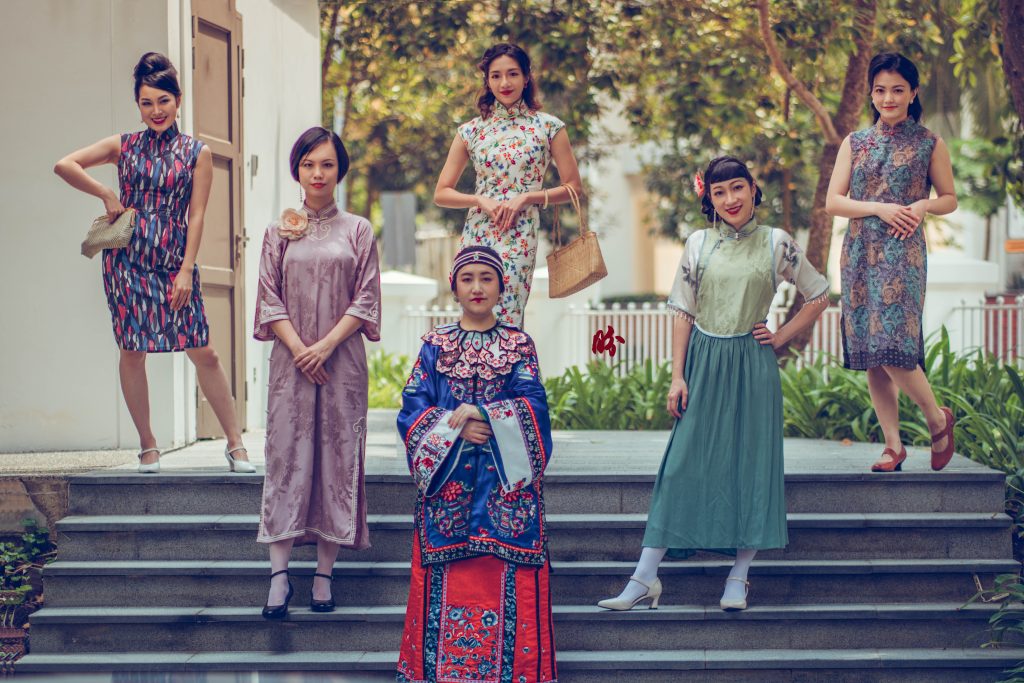
Styling support from Dressed Up Dreams and Lin Tong with selected vintage pieces from Collector Lin Tong.
Photo and edited by Hanfugirl. This image displays the evolution in Chinese women’s fashion from late Qing to the 1900s.
The origin of modern Cheongsam has been hotly debated throughout the centuries, by people with different ideology and agenda. Its original form was claimed by:
a) Feminists to be the male long robe (thus the Cantonese name “cheong” which means long, “sam” which means top), and that women wore them in the attempt of trying to be seen as equals of men;
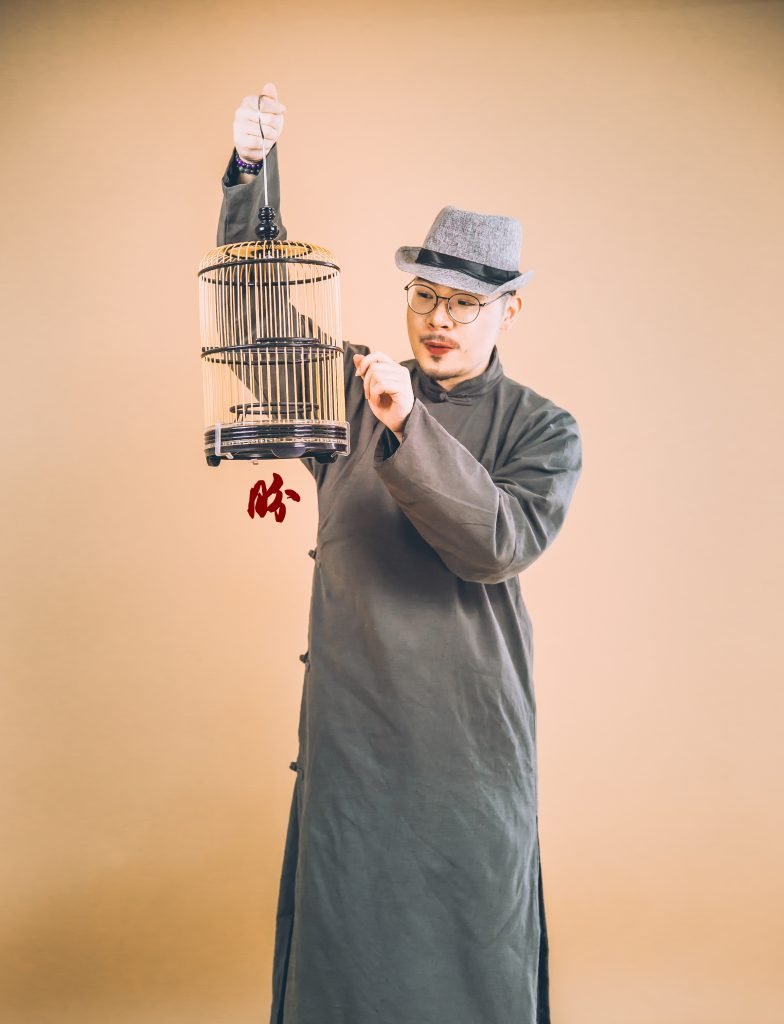
b) Han chauvinists to be a continuation of the long lineage of wearing a one-piece robe since the Han dynasty ;

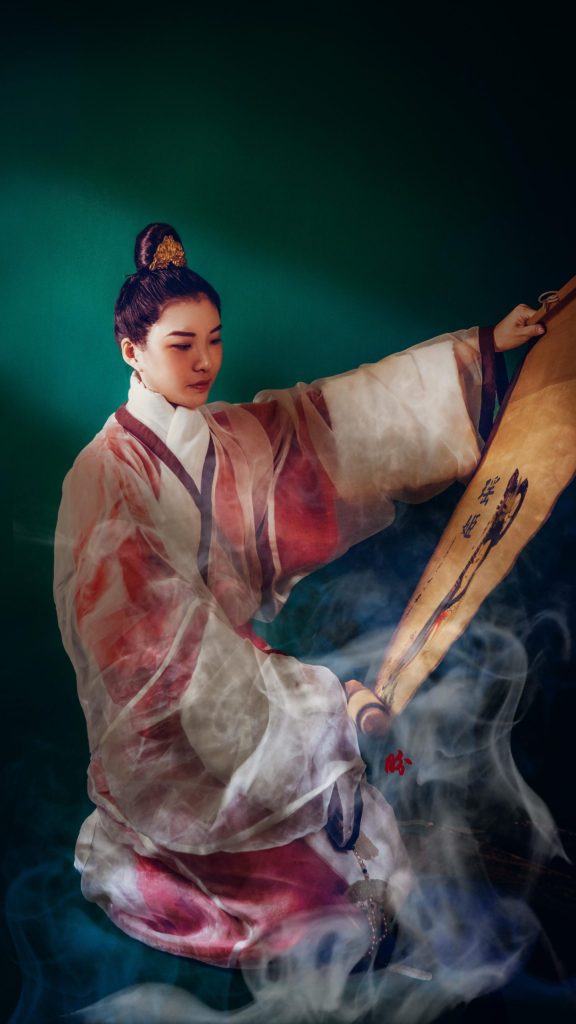
c) General public as originating from the Manchurian (the banner people) thus the term in Chinese “Qi” (banner) and “Pao” (robe) aka robe of the banner people. Although, technically there was Han Chinese who were banner people too, but you know, nuances are often lost in mass messaging.
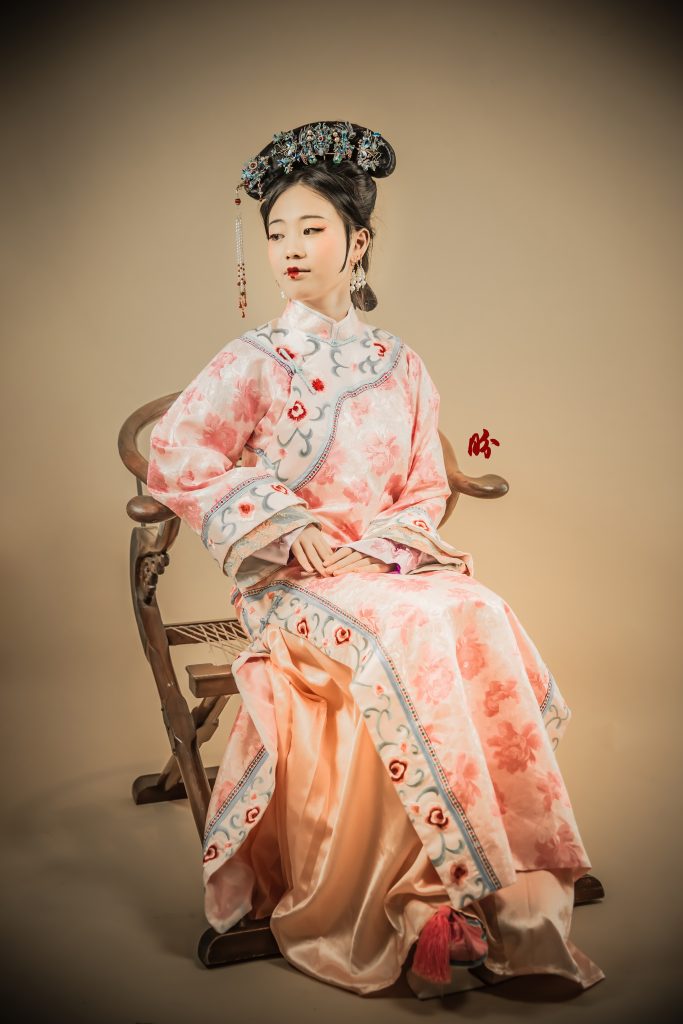
amongst many others.
I love how etymology of names give us so much insight into how something evolved or was perceived throughout history.
Similar to the Cheongsam, the Manchurian Riding Jacket also has its contentious origin story (some said it was the Ming Chinese’s jackets, some saw it as more Manchurian), and both became symbols of Chinese traditional wear in the modern era. One more famous than the other in origin story (because it’s sexier to associate a style with ideology than just pure fashion, although both are likely products of changing fashion taste and that lingering love for the past).
SYMBOL OF POWER AND CONNECTION
If you’ve watched enough Qing dynasty Chinese drama, you would often hear of the emperor bestowing a “Yellow Riding Jacket”(黄马褂) to someone who’s made it in his professional life as a court official. And it looks like this:

But guess what, you don’t have to make it in life as a high rank administrative officer to wear it after all! It was also a uniform for certain jobs in the palace. So certain public imperial servants could still get to wear them during office hours, or when they go on official duties like hunting with the emperor.
The Manchurian Riding Jacket originally was originally reserved for the banner troops during their official trips to surrounding areas with the emperor or when they go hunting with the emperor. Because of the need for greater mobility, you’d realise that the jacket as well as the sleeves are all pretty short.

Overtime, it lost its original formality (another story for another day) and was incorporated into the casual wear without too much restrictions on the occasion and people who were allowed to wear it.
With such freedom comes great diversity and women started wearing them, and it developed into all kinds of styles—long sleeves, short sleeves, broad sleeves, narrow sleeves, round collar, mandarin collar, side buttoned, front buttoned etc. It became extremely elaborate with lots of embroideries as decoration which are iconic of Qing dynasty dresses.
Fun fact: Mandarin collar isn’t so Manchurian (origin of the name Mandarin) after all! Manchurian dressing originally did not have collars. The blue collars you often seen in paintings and photographs were fake collars that were just added to the top of the dresses. It was towards the late Qing that they became integrated with the robes and tops.

So while everyone knows the cheongsam (long robe) that the Chinese men in Qing dynasty wore, and how it has become quite an iconic traditional wear for modern Chinese men, people forgot that it used to be worn with a riding jacket on top. In fact, it wouldn’t be considered proper unless you have the top vest.
Also why in many of the late Qing-Republic era shows, you’d see the rich men wearing a damask riding jacket top over his long robe:

When Charlie Chaplin met with Peking Opera icon Mei Lanfang in 1930, Mei Lanfang wore the riding jacket over his long robe which was the proper thing to do:

Both men and women were having lots of fun with colours and it was quite fascinating:
HIS


HERS



Look here’s a painting of Empress Dowager Cixi and her colourful riding jacket:

The Riding Jackets have 4 slits to facilitate movements—2 at the sides, one front and one back:


With our modernised cropped jacket, we only have three slits (two sides and the front), and done way with the back slit for simplicity purpose. But we retained the damasks on the base fabric. Damasks are believed to be invented by the Chinese as early as the Tang dynasty (circa 7th century CE), and you have to see them to love them because they’re so subtle that it’s almost invisible on photographs from afar.
DAMASKS
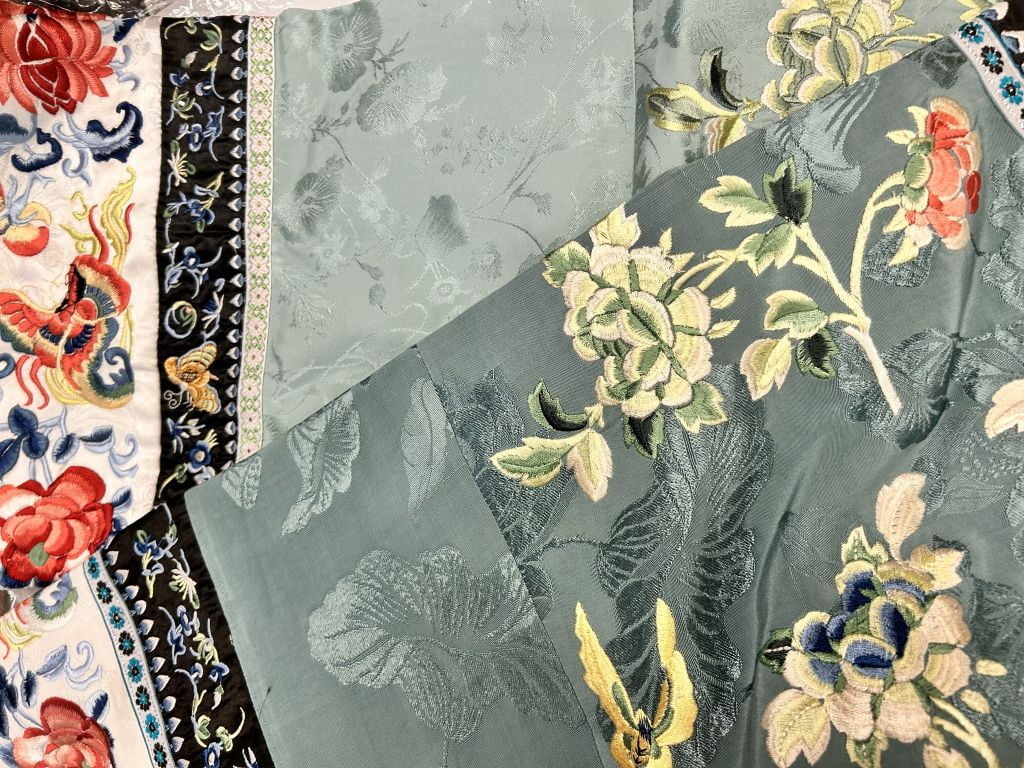
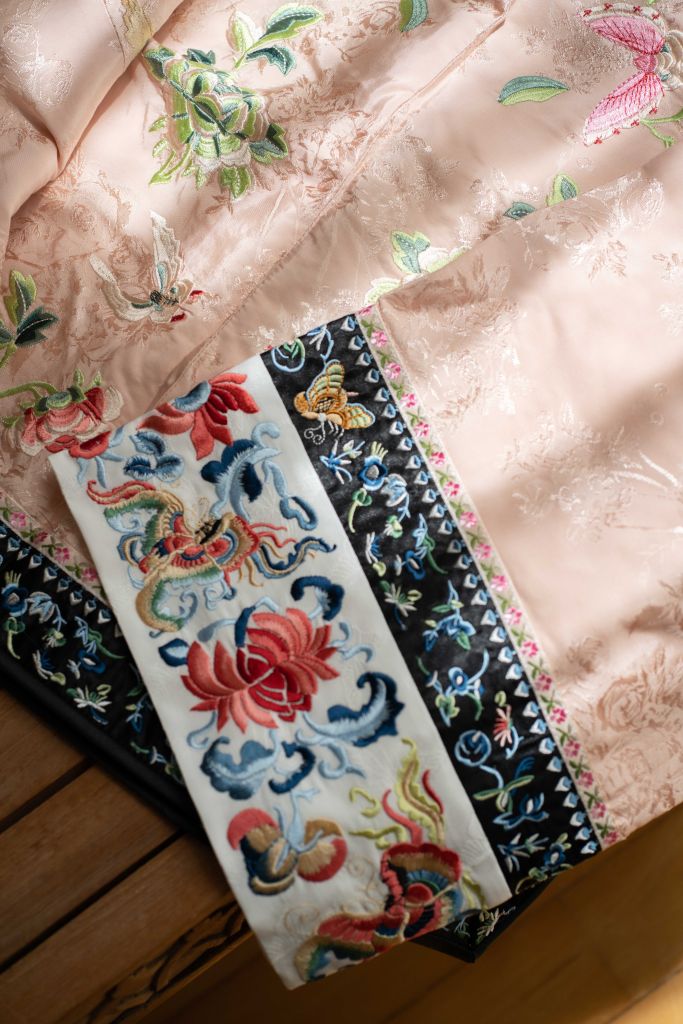

This is where we get a bit technical on the weave. Most people are familiar with the Chinese embroideries which floats above the surface of the base fabric. But the weaving style and patterns were equally important in adding different layers of texture and beauty to the fabric.
Damask is one of my favourite weaves which is also quintessentially Chinese. These subtle patterned textiles became known as ‘damask’ after the Syrian city of Damascus, which may have been where these textiles were first encountered by the Crusaders. But the Chinese have been weaving them for hundreds of years before they were introduced to Europe via the Middle East.
Personally, I find it very representative of the understated luxury that the Chinese are so fond and after owning damask pieces, I find it very hard to go back to simple weave plain pieces because it feels very flat and lacking in character. I would love to hear from you if you own a damask piece, and what’s your thought on this!
INTERNATIONAL CONNECTION
What’s interesting is that in the Korean traditional dress, they have something by the name of Magoja (马褂子)which was evolved from the Manchurian Riding Jacket (马褂). Yes, one word difference only!

MODERN CHINESE ADOPTION IN MALE GARMENT
I’ve mentioned that initially the Riding Vests were for men on a hunt with the Emperor, but eventually due to the relaxation of the rule on who could wear it, it became part of the casual wear and women started embracing them with great fervour. While it was unisex (like the cheongsam) at the turn of the 20th century, like Cheongsam too, it evolved to something more gendered in the 21st century.
You can see its influence in what we call the traditional Chinese top for men —the Tang Wear 唐装(although women do wear them but it wasn’t as popular because, just look at it… I wouldn’t):
[Image of world leaders wearing Tang-style jackets (Tang Zhuang) at the 2001 APEC Summit was originally shown here. It has been removed following a copyright notice from Agence France-Presse (AFP). Readers may easily locate the reference image online for context.]
It is for this reason, that we launched the Qing Revival Cropped Jacket series this Chinese New Year period (Sale of $20 off till end Feb 2024) which is inspired by the Manchurian Riding Jacket. It is an attempt to bring attention to the lost twin of Cheongsam, which has similar importance and popularity in history, and the male form of which also went on to be incorporated into the 20th century’s wardrobe with international recognition (although most wouldn’t know its origin story now).






This is available in multiple shades, just as how it would’ve been in the past with its brilliant colours and embroideries except that it’s MACHINE WASHABLE (god-sent!) as it is rayon (softer than polyester and feels really comfortable).
Items are made by women in the Hmong and Kam autonomous region in China (although the embroideries are machine-made), and if you’re familiar with their style, they love elaborate embroidery design works on their garments too!
Orders (unless it is ready stock) are likely to be shipped out only after Chinese New Year towards mid to end March from Singapore. So you probably won’t get it by the Chinese New Year but, you can always wear it in the new years to come!
FUSION PHOTOSHOOT
On that note, there’s this photo of a Manchurian woman (you can see it in her unbound feet in the Manchurian platform shoes) wearing a riding jacket, but with a Han chinese hairdo. According to some descriptions she was holding a bible in her hand. The fusion is really interesting. And yes, even in the black and white photo you could vaguely see the damask pattern!

This is also why I choose the key visual of this pose to be a fusion. A Han Chinese hairstyle with the Manchurian Riding Jacket cropped jacket and a modernised Mamian skirt of the Han Chinese:

Same same, but different.
Note: The previously embedded AFP photograph depicting the 2001 APEC Summit attire was removed in compliance with copyright requirements. The image remains widely available in public news archives.

Leave a Reply